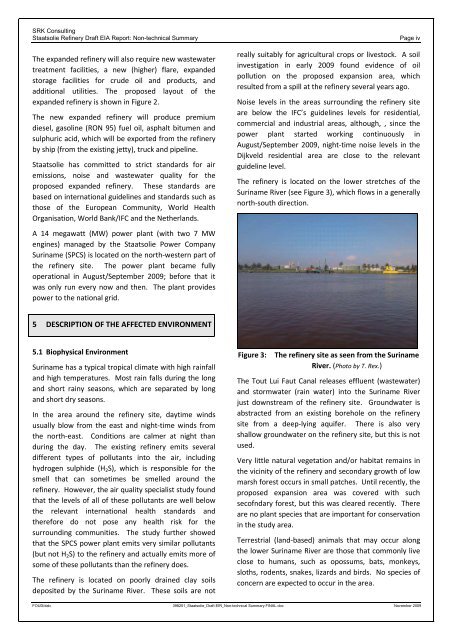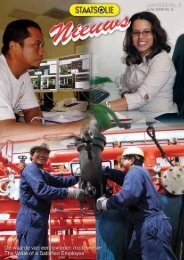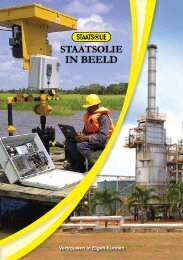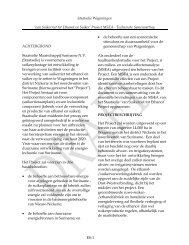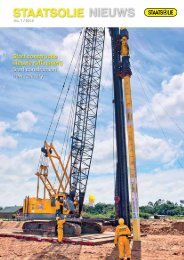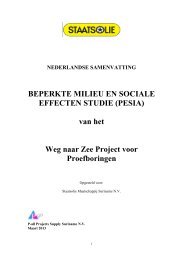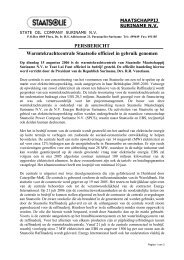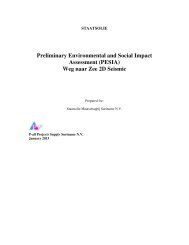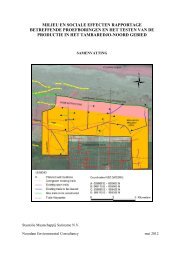English - Staatsolie
English - Staatsolie
English - Staatsolie
Create successful ePaper yourself
Turn your PDF publications into a flip-book with our unique Google optimized e-Paper software.
SRK Consulting<br />
<strong>Staatsolie</strong> Refinery Draft EIA Report: Non-technical Summary Page iv<br />
The expanded refinery will also require new wastewater<br />
treatment facilities, a new (higher) flare, expanded<br />
storage facilities for crude oil and products, and<br />
additional utilities. The proposed layout of the<br />
expanded refinery is shown in Figure 2.<br />
The new expanded refinery will produce premium<br />
diesel, gasoline (RON 95) fuel oil, asphalt bitumen and<br />
sulphuric acid, which will be exported from the refinery<br />
by ship (from the existing jetty), truck and pipeline.<br />
<strong>Staatsolie</strong> has committed to strict standards for air<br />
emissions, noise and wastewater quality for the<br />
proposed expanded refinery. These standards are<br />
based on international guidelines and standards such as<br />
those of the European Community, World Health<br />
Organisation, World Bank/IFC and the Netherlands.<br />
A 14 megawatt (MW) power plant (with two 7 MW<br />
engines) managed by the <strong>Staatsolie</strong> Power Company<br />
Suriname (SPCS) is located on the north-western part of<br />
the refinery site. The power plant became fully<br />
operational in August/September 2009; before that it<br />
was only run every now and then. The plant provides<br />
power to the national grid.<br />
5 DESCRIPTION OF THE AFFECTED ENVIRONMENT<br />
5.1 Biophysical Environment<br />
Suriname has a typical tropical climate with high rainfall<br />
and high temperatures. Most rain falls during the long<br />
and short rainy seasons, which are separated by long<br />
and short dry seasons.<br />
In the area around the refinery site, daytime winds<br />
usually blow from the east and night-time winds from<br />
the north-east. Conditions are calmer at night than<br />
during the day. The existing refinery emits several<br />
different types of pollutants into the air, including<br />
hydrogen sulphide (H2S), which is responsible for the<br />
smell that can sometimes be smelled around the<br />
refinery. However, the air quality specialist study found<br />
that the levels of all of these pollutants are well below<br />
the relevant international health standards and<br />
therefore do not pose any health risk for the<br />
surrounding communities. The study further showed<br />
that the SPCS power plant emits very similar pollutants<br />
(but not H2S) to the refinery and actually emits more of<br />
some of these pollutants than the refinery does.<br />
The refinery is located on poorly drained clay soils<br />
deposited by the Suriname River. These soils are not<br />
really suitably for agricultural crops or livestock. A soil<br />
investigation in early 2009 found evidence of oil<br />
pollution on the proposed expansion area, which<br />
resulted from a spill at the refinery several years ago.<br />
Noise levels in the areas surrounding the refinery site<br />
are below the IFC’s guidelines levels for residential,<br />
commercial and industrial areas, although, , since the<br />
power plant started working continuously in<br />
August/September 2009, night-time noise levels in the<br />
Dijkveld residential area are close to the relevant<br />
guideline level.<br />
The refinery is located on the lower stretches of the<br />
Suriname River (see Figure 3), which flows in a generally<br />
north-south direction.<br />
Figure 3: The refinery site as seen from the Suriname<br />
River. (Photo by T. Rex.)<br />
The Tout Lui Faut Canal releases effluent (wastewater)<br />
and stormwater (rain water) into the Suriname River<br />
just downstream of the refinery site. Groundwater is<br />
abstracted from an existing borehole on the refinery<br />
site from a deep-lying aquifer. There is also very<br />
shallow groundwater on the refinery site, but this is not<br />
used.<br />
Very little natural vegetation and/or habitat remains in<br />
the vicinity of the refinery and secondary growth of low<br />
marsh forest occurs in small patches. Until recently, the<br />
proposed expansion area was covered with such<br />
secofndary forest, but this was cleared recently. There<br />
are no plant species that are important for conservation<br />
in the study area.<br />
Terrestrial (land-based) animals that may occur along<br />
the lower Suriname River are those that commonly live<br />
close to humans, such as opossums, bats, monkeys,<br />
sloths, rodents, snakes, lizards and birds. No species of<br />
concern are expected to occur in the area.<br />
FOUD/dalc 398251_<strong>Staatsolie</strong>_Draft EIR_Non-technical Summary FINAL.doc November 2009


